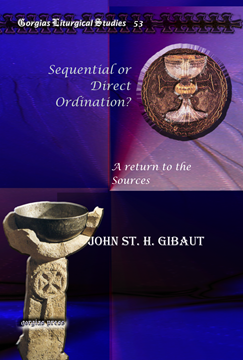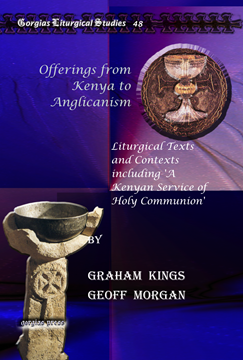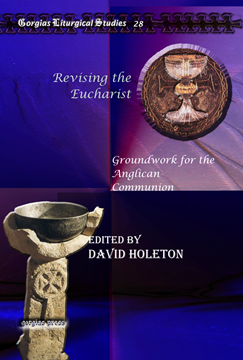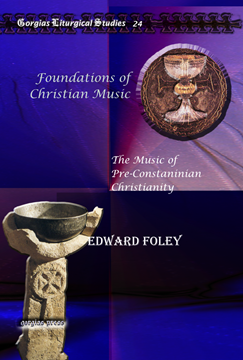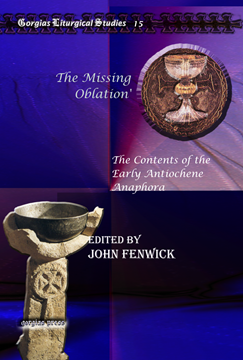Recently viewed products
Kiraz Liturgical Studies
This series provides a venue for studies about liturgies as well as books containing various liturgies. Making liturgical studies available to those who wish to learn more about their own worship and practice or about the traditions of other religious groups, this series includes works on service music, the daily offices, services for special occasions, and the sacraments.
Sequential or Direct Ordination?
A return to the Sources
Series: Kiraz Liturgical Studies 53
ISBN: 978-1-60724-404-2
In the Anglican Communion, the medieval practice, which certainly had some earlier roots, continued—that ordination came to any one individual in this 'sequence': deacon, presbyter, bishop. The Anglican ordinal was so committed to this pattern at the Reformation that Cranmer's text prayed that deacons 'may so well use themselves in this inferior office, that they may be found worthy to be called unto higher ministries in thy Church.' Latterly, however, Anglicans have not only sought to develop the calling of a deacon in his or her own right, but have in some places and cases promoted the idea that the true calling of a deacon and of a presbyter would be best clarified by a separate 'direct' ordination. John Gibaut, a liturgical theologian of the Anglican Church of Canada, presents the case for 'direct' ordination—rooting it in the patristic era, and spelling out its implications in the present day.
$138.00 (USD)
Offerings from Kenya to Anglicanism
Liturgical Texts and Contexts including 'A Kenyan Service of Holy Communion'
By Graham Kings & Geoff Morgan
Series: Kiraz Liturgical Studies 48
ISBN: 978-1-60724-399-1
The 1989 Kenyan eucharistic text has had much publicity, including its use at the opening service of the 1998 Lambeth Conference, but has had little in the way of introduction or commentary. These two authors, with much Kenyan experience and with encouragement from the key persons in Kenya, here provide the text with a valuable contextual exposition.
$138.00 (USD)
The Syriac Version of the Liturgy of St James
A brief history for Students
Series: Kiraz Liturgical Studies 47
ISBN: 978-1-60724-398-4
This is a Study which will open windows galore for Westerners, for not only is the history as recorded likely to cover ground untrodden by most English-speaking liturgists, but equally the surrounding field of study and its other scholarly occupants (who are laid heavily under contribution) will also be largely unknown.
$138.00 (USD)
The Eucharistic Doctrine of The Later Nonjurors
A Revisionist View of the 18th-Century Usages Controversy
By James Smith
Series: Kiraz Liturgical Studies 45
ISBN: 978-1-60724-396-0
The division between the 'Usagers' and the 'Non-Usagers' is fairly well known, but is here clarified and charted in detail but within a view of the overall non-juring situation.
$138.00 (USD)
Welcoming the Baptized
Anglican Hospitality within the Ecumenical Enterprise
Series: Kiraz Liturgical Studies 34
ISBN: 978-1-60724-385-4
Issues associated with ecumenism and the reception of other Christians in Anglicanism and other associated concerns form the topic of this brief examination.
$138.00 (USD)
The Comparative Liturgy of Anton Baumstark
By Fritz West
Series: Kiraz Liturgical Studies 31
ISBN: 978-1-60724-382-3
An homage to Anton Baumstack and his comparative liturgy. This brief study includes an intellectual biography and his method and comparative practice in regards to liturgy.
$138.00 (USD)
Revising the Eucharist
Groundwork for the Anglican Communion
Edited by David Holeton
Series: Kiraz Liturgical Studies 28
ISBN: 978-1-60724-379-3
Studies in Preparation for the 1995 Dublin Consultation.
$138.00 (USD)
Foundations of Christian Music
The Music of Pre-Constaninian Christianity
By Edward Foley
Series: Kiraz Liturgical Studies 24
ISBN: 978-1-60724-375-5
Taking a wider historical scope, this booklet examines the auditory environment and the temple of Herod as well as first century synagogues. Music in borrowed spaces and house churches of early Christianity conclude the study.
$142.00 (USD)
The Missing Oblation'
The Contents of the Early Antiochene Anaphora
Edited by John Fenwick
Series: Kiraz Liturgical Studies 15
ISBN: 978-1-60724-366-3
This concise study considers the Anaphoras of the Apostles and the Liturgy of John Chrysostom. Also included is the relationship between these pieces and the Anaphora of the Apostolic Constitutions book viii.
$138.00 (USD)


